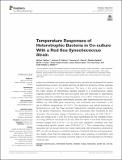Por favor, use este identificador para citar o enlazar a este item:
http://hdl.handle.net/10261/318696COMPARTIR / EXPORTAR:
 SHARE SHARE
 CORE
BASE CORE
BASE
|
|
| Visualizar otros formatos: MARC | Dublin Core | RDF | ORE | MODS | METS | DIDL | DATACITE | |

| Título: | Temperature Responses of Heterotrophic Bacteria in Co-culture With a Red Sea Synechococcus Strain |
Autor: | Labban, A; Palacio, A; García-García, Francisca del Carmen; Hadaidi, G; Ansari, MI; López-Urrutia-Lorente, Ángel; Alonso-Saez, L; Morán, Xosé Ánxelu Gutiérrez | Palabras clave: | Medio Marino Centro Oceanográfico de Gijón |
Fecha de publicación: | 10-may-2021 | Resumen: | Interactions between autotrophic and heterotrophic bacteria are fundamental for marine biogeochemical cycling. How global warming will affect the dynamics of these essential microbial players is not fully understood. The aims of this study were to identify the major groups of heterotrophic bacteria present in a Synechococcus culture originally isolated from the Red Sea and assess their joint responses to experimental warming within the metabolic ecology framework. A co-culture of Synechococcus sp. RS9907 and their associated heterotrophic bacteria, after determining their taxonomic affiliation by 16S rRNA gene sequencing, was acclimated and maintained in the lab at different temperatures (24–34°C). The abundance and cellular properties of Synechococcus and the three dominant heterotrophic bacterial groups (pertaining to the genera Paracoccus, Marinobacter, and Muricauda) were monitored by flow cytometry. The activation energy of Synechococcus, which grew at 0.94–1.38 d–1, was very similar (0.34 ± 0.02 eV) to the value hypothesized by the metabolic theory of ecology (MTE) for autotrophs (0.32 eV), while the values of the three heterotrophic bacteria ranged from 0.16 to 1.15 eV and were negatively correlated with their corresponding specific growth rates (2.38–24.4 d–1). The corresponding carrying capacities did not always follow the inverse relationship with temperature predicted by MTE, nor did we observe a consistent response of bacterial cell size and temperature. Our results show that the responses to future ocean warming of autotrophic and heterotrophic bacteria in microbial consortia might not be well described by theoretical universal rules. | URI: | http://hdl.handle.net/10261/318696 | DOI: | https://doi.org/10.3389/fmicb.2021.612732 | ISSN: | 1664-302X |
| Aparece en las colecciones: | (IEO) Artículos |
Ficheros en este ítem:
| Fichero | Descripción | Tamaño | Formato | |
|---|---|---|---|---|
| fmicb-12-612732.pdf | Articulo | 2,17 MB | Adobe PDF |  Visualizar/Abrir |
CORE Recommender
Page view(s)
29
checked on 16-may-2024
Download(s)
18
checked on 16-may-2024
Google ScholarTM
Check
Altmetric
Altmetric
Este item está licenciado bajo una Licencia Creative Commons

